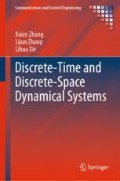Abstract
In Chaps. 4 and 5, we investigated how to verify different notions of observability and detectability for Boolean control networks (BCNs), and also studied how to determine the initial state (current state) of a BCN according to a particular notion of observability (detectability). In addition, we proved that the problems of verifying these notions are all NP-hard in the number of nodes. Hence, these problems are generally intractable. Actually, in general, for a BCN with more than 30 nodes, one cannot obtain whether it is observable or detectable in a reasonable amount of time by using a personal computer (PC). Hence BCNs with more than 30 nodes can be regarded as large-scale.
Access this chapter
Tax calculation will be finalised at checkout
Purchases are for personal use only
References
Akutsu T et al (1998) A system for identifying genetic networks from gene expression patterns produced by gene disruptions and overexpressions. Genome Inform Work Genome Inform 9:151–160
Fauré A et al (2006) Dynamical analysis of a generic Boolean model for the control of the mammalian cell cycle. Bioinformatics 22(14):e124
Fornasini E, Valcher ME (2013) Observability, reconstructibility and state observers of Boolean control networks. IEEE Trans Autom Control 58(6):1390–1401
Ishii H, Tempo R, Bai EW (2012) A web aggregation approach for distributed randomized pagerank algorithms. IEEE Trans Autom Control 57(11):2703–2717
Klamt S et al (2006) A methodology for the structural and functional analysis of signaling and regulatory networks. BMC Bioinform 7(56):1–26
Laschov D, Margaliot M (2013) Minimum-time control of Boolean networks. SIAM J Control Optim 51(4):2869–2892
Laschov D, Margaliot M, Even G (2013) Observability of Boolean networks: a graphtheoretic approach. Automatica 49(8):2351–2362
Li R, Yang M, Chu T (2015) Controllability and observability of Boolean networks arising from biology. Chaos: Interdiscip J Nonlinear Sci 25(2):023104–15
Liu Y-Y, Slotine J-J, Barabási A-L (2013) Observability of complex systems. Proc Natl Acad Sci 110(7):2460–2465
Louati A, Aufaure MA, Lechevallier Y (2013) Graph aggregation: application to social networks. In: Guan R et al (eds) Advances in theory and applications of high dimensional and symbolic data analysis, vol RNTI-E-25, Hermann, pp 157–177
Veliz-Cuba A et al (2014) Steady state analysis of Boolean molecular network models via model reduction and computational algebra. BMC Bioinform 15(1):221
Zhang K, Johansson KH (2018) Efficient observability verification for large-scale Boolean control networks. In: 2018 37th Chinese control conference (CCC), pp 560–567
Zhang K, Zhang L, Xie L (2015) Invertibility and nonsingularity of Boolean control networks. Automatica 60:155–164
Zhang R et al (2008) Network model of survival signaling in large granular lymphocyte leukemia. Proc Natl Acad Sci USA 105:16308–13
Zhao Q (2005) A remark on scalar equations for synchronous boolean networks with biological applications by CF arrow, J Heidel, J Maloney, J Rogers. IEEE Trans Neural Netw 16(6):1715–1716
Zhao Y, Ghosh BK, Cheng D (2016) Control of large-scale Boolean networks via network aggregation. IEEE Trans Neural Netw Learn Syst 27(7):1527–1536
Zhao Y, Kim J, Filippone M (2013) Aggregation algorithm towards large-scale Boolean network analysis. IEEE Trans Autom Control 58(8):1976–1985
Author information
Authors and Affiliations
Corresponding author
Rights and permissions
Copyright information
© 2020 Springer Nature Switzerland AG
About this chapter
Cite this chapter
Zhang, K., Zhang, L., Xie, L. (2020). Observability and Detectability of Large-Scale Boolean Control Networks. In: Discrete-Time and Discrete-Space Dynamical Systems. Communications and Control Engineering. Springer, Cham. https://doi.org/10.1007/978-3-030-25972-3_6
Download citation
DOI: https://doi.org/10.1007/978-3-030-25972-3_6
Published:
Publisher Name: Springer, Cham
Print ISBN: 978-3-030-25971-6
Online ISBN: 978-3-030-25972-3
eBook Packages: Intelligent Technologies and RoboticsIntelligent Technologies and Robotics (R0)

